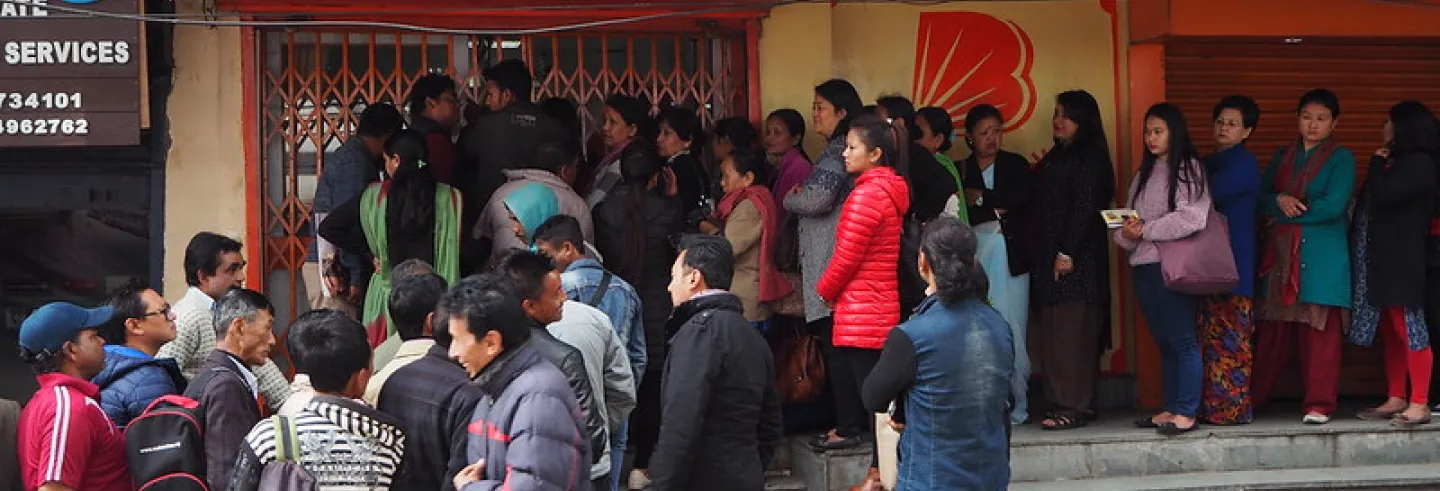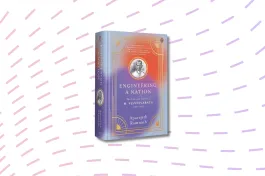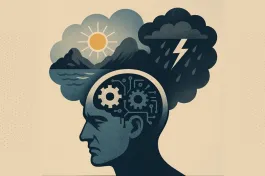Economic policy is often driven more by popular narratives than by economic analysis. Significant economic events too generate their own narratives. Indeed, they often span multiple narratives, some overlapping and others conflicting with each other. Sometimes a single narrative gets the most traction and becomes the dominant one, exerting a powerful influence on popular understanding of the event. The dominant narrative may well be based on truth, but, more important, it is grounded in the cultural belief systems and folklore of that society. The 2016 demonetisation of high-value currency in India is one such case.
Although there are many studies and media reports on the Indian demonetisation of 2016, to my knowledge, not much has been said about the narratives that drove this event.
Do narratives matter in economics?
In history, anthropology or politics, the study of narratives is seen as key to understanding an epoch, but it tends to be mostly ignored in economics. Economic literature has a wealth of studies of economic crises as on the Great Depression (1929-40) and more recently, the Great Financial Crisis of 2008. In all this work, very little attention is given to the nature of the narratives that underlie these events. Robert Schiller describes the power of narratives in the understanding of major economic events thus:
The first narrative of the Great Depression was that of the stock market drop on October 28, 1929. This narrative was especially powerful, in its suddenness and severity, focusing public attention on a crash as never before in America. (… )There was something timed very well about this story, that caused an immediate and lasting public reaction. (Schiller 2017)
The Great Depression spanned a long period, from 1929 – 1941. Economists writing during and since that period have identified a host of factors responsible. Yet the narrative of the stock market crash of October 1929 came to represent the folklore of the Great Depression.
To quote Schiller again,
Where did the 1929 crash narrative get such strength? Part of the strength seems to come from certain moralizing. The fact that the 1920s had been not only a time of economic superabundance but also of sexual liberation.
The news stories and the sermons preached from the pulpits across America attributed the crash to the moral and spiritual decay of the society. The sermons and the editorials helped to shape a narrative, which was in part a morality tale and a sort of day-of-judgment on the era that later came to be known as the “Roaring Twenties”. In short, the Great Crash was a satisfying apocalyptic denouement so rarely found.
What were the consequences of this narrative? Initially, there was reluctance to revive the economy by substantial public expenditure. When Franklin D. Roosevelt was elected US president in 1932, and launched the New Deal, ambitious as it was, it was ultimately too modest to fully counteract the Great Depression and spluttered out by the time of the next election. So great was the fear of government profligacy 1 Ultimately it took the vast expenditure of the war to fully overcome the Great Depression. .
[N]arratives in economics, as in other social sciences, create myths, which endure despite rational appeal to facts.
Let us consider another popular narrative from Germany, on the Weimar hyperinflation. From around late 1922 to the beginning of 1924, hyperinflation on a scale never imagined devastated the already defeated Germany. The saga of German people seeing their savings and pensions erode overnight, and carrying a barrow-load of Marks to buy bread is so deeply embedded in the German consciousness that even now, nearly a hundred years after the event, German society retains a deep-rooted memory of the event. This is reflected in the way German society treasures the stability of the currency and conversely distrust public debt. The Euro in German eyes would be acceptable as long as it resembled the beloved Deutsch Mark it replaced 2 The Maastricht criteria to join the Eurozone; low inflation (>1.5%), low-interest rate, low budgetary deficit (not more than 3% of GDP), low public debt (not more than 60%) , were mainly set by Germany and northern European states. .
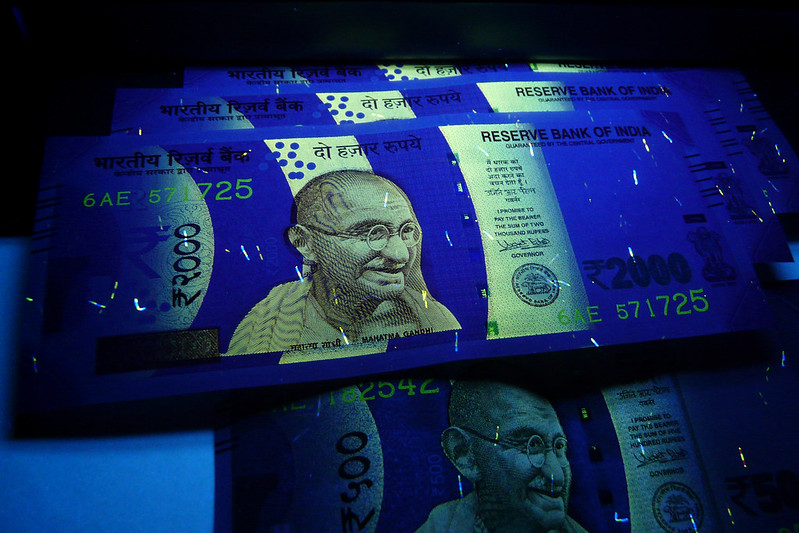
Thus, folklore and memory permeate the discussion of public debt. That hyperinflation had less to do with the high level of debt than other proximate causes is mostly forgotten. The analogy with household finance is applied to public finance; the idea of living within one’s income is a higher moral and economic virtue, applicable as much to a nation as to a household. Besides, deep-seated religious and cultural beliefs engender a value system that frowns upon profligacy. Debt equals living beyond one’s means, a sure means of downfall.
Calvinism and other Protestant theologies explicitly linked hard work and austere living as a basis for a just and prosperous society 3 Max Weber gave this a theoretical framework in his seminal work “The Protestant Ethic and the spirit of Capitalism”. . Nevertheless, studies have shown that more than its work ethic, the impact of Protestantism perhaps lay in human capital development through widespread literacy, starting with the translation of the Bible into local languages, and the emphasis on universal education and social security that created the basis for economic prosperity (Schaltegger 2009).
Indeed, narratives in economics, as in other social sciences, create myths, which endure despite rational appeal to facts. This is also true for the “Demonetisation” of 2016 in India.
The Demonetisation story
The story of demonetisation is by now well-known.
Within hours of the prime minister’s announcement on 8 November 2016, high-value currency notes of Rs. 500 and Rs. 1000, amounting to some 86% of the total value of all banknotes in circulation, ceased to be legal tender.
The declared objectives of this extraordinary action were initially described as the flushing out of “black money” from the system, as well as reducing terrorist financing and counterfeit currency. Later more goals were added, such as moving towards a “less cash and more digital “economy, increased tax compliance, and a greater formalisation of the economy.
As documented by several studies, 4 Including the studies cited as well as several not explicitly referenced. most of the objectives were not fulfilled.
One, flushing out of black money and the claims of windfall gains of some Rs 2-3 trillion failed to materialise as more than 99.3% of the cancelled notes returned to the banks of (RBI 2018-19, ). If black money had existed as stockpiles of illegal cash, clearly all of it was very efficiently laundered.
Two, the claim about counterfeiting was always dubious. The estimates of counterfeit currency in circulation rarely exceeded a minuscule amount (0.02% or less of cash in circulation), and there is no evidence this would stop with the introduction of new currency notes.
Three, although there has been a significant increase in the number of tax returns post-demonetisation, the ratio of direct taxes to GDP remains low, averaging around 5.7%, well below the peak of 6.3 % reached in 2007-8 (CBDT).
Four, cashless, especially digital, payments did register a significant jump in volume terms in 2016-17 before returning to robust but more modest growth. Recent data suggests a plateauing, which might indicate hitting capacity constraints in growth of the digital transactions. Globally, in comparison with other systemically important emerging economies such as Brazil, Mexico, Indonesia, India is still an underperformer in digitalisation of financial transactions.
Five, and perhaps the most telling evidence of the failure of the “less cash more digital” policy can be seen in the developments of currency-GDP ratios over the past four years. The currency- in-circulation has grown steadily with increasing pace of remonetisation, and as of March 2020, it was 12.3 percent of the GDP, a little higher than at the time of demonetisation. And, post-COVID, cash is back with a vengeance, and with more higher denomination notes in circulation 5 The share of bank deposits in household financial savings rose substantially (63%) in the year of demonetisation and came down steeply in the following year (31%) and continued to be lower than the pre-demonetisation years. The share of currency as a component of household financial savings, which fell sharply (-20%) in the aftermath of demonetisation, rebounded sharply in the following year (+28%) and is now higher than the pre-demonetisation period. (RBI Annual Report 2019-20, Table 11.1.2, P 25). .
By every measure, demonetisation as economic policy was a gross failure…But paradoxically, as a narrative, it was presented and received in an altogether different light.
Several estimates show the loss of output due to demonetisation between Rs. 1.15 -1.5 trillion, or around 0.75 -1.0% of nominal GDP for 2016-17 (Chodorow-Reich 2018, Economic Survey 2016-17, Vyas 2016). Beyond the macroeconomic costs, the poor and the lower middle class bore the brunt of its impact. The mostly cash-based unorganised sector, which employed over 90% of the labour force, was especially hit hard.
How lasting was the economic impact of demonetisation is not yet known. A recent study found a significant heterogeneity in the impact across households in different asset quartiles (Karmakar and Narayanan, 2020). The study also found evidence of recovery of household finances albeit with an increase in household borrowing from different sources.
For the poor in urban and rural areas, cash is essential for sustenance and saving. Millions of households had saved small amounts over time, mostly in demonetised currency. Women were more at risk, saving their precious hoard from their menfolk as well as from external calamities. Much has been written about the hardships faced in exchange or bank deposits, spending hours and days in long queues. Multitudes relied on private agents and middlemen and paid a hefty premium to get their own money back.
By every measure, demonetisation as economic policy was a gross failure. It was not merely a failure but an egregious act of cruelty and suffering for a large section of the population. Perhaps unintended, it reflected a complete lack of understanding of the functioning of the cash economy, a total failure in planning an exercise of this magnitude, and an utter lack of imagination of the scale of disruption that was going to occur in the country. But paradoxically, as a narrative, it was presented and received in an altogether different light.
The role of the narrative in the demonetisation story
What role did popular narratives play in selling the demonetisation story? How did these narratives shape the public perception? To answer these questions, we need to look at three overlapping themes. One, how was the narrative created and disseminated. Two, what were its core messages? And three, how were they received?
Selling a narrative
In the historical examples of the Great Depression, Weimar hyperinflation and Calvinism, the dominant narratives were created in many ways by politicians, media, academics and, sometimes by the clergy. This was also how the demonetisation story was broadly created and disseminated. But what was unusual in this case was that a narrative was built into the policy and sold successfully. A key factor was the overwhelming one-sided nature of messaging, uncritical support from the mass media and social media, which left little scope for a counter narrative to gain ground. But beyond these already substantial advantages, the core element in selling the narrative was to stake the high moral ground and remain there.
The way the narrative was framed, it was hard for its critics to explain their opposition. To denounce it outright would suggest that they have a vested interest in defending black money and corruption. (Hasan 2017, Khera 2017)
The prime minister’s announcement of the demonetisation was carefully designed to appeal to the “common people” with a mix of overt and subliminal messages. Demonetisation was declared essential in the fight with various evils blocking the nation’s progress in the interest of crores of common people who lead a life of honesty and integrity.
Which honest citizen would not be pained by reports of crores worth of currency notes stashed under the beds of government officers? Or by reports of cash found in gunny bags? (Prime Minister’s speech on 8 November 2016)
The very effective use of such vivid imagery, easily recognised and widely understood, was an important element in building a narrative. The crores of common people who felt the full impact of demonetisation, had not only witnessed corruption in government offices or in real estate transactions, but had also seen this play out in the cinema, newspaper stories or in daily conversation over the years.
Demonetisation was declared essential in the fight with various evils blocking the nation’s progress in the interest of crores of common people who lead a life of honesty and integrity.
The narrative shifted as the situation changed. As it became clear that the cancelled currency was being returned to the banks in larger numbers than expected, the narrative changed focus from black money and fake currency to digital/cashless payments, the latter being elevated to some higher purpose than what it actually is, a technological change. While different objectives were interspersed, the core narrative of the battle against corruption remained to be headlined when required.
The media, with honourable exceptions, played its role, dutifully repeating the talking points. Where the objective realities of people suffering, in long queues, visible distress of the poor or the farmers dumping their produce, could not be hidden or ignored, the blame was shifted to poor implementation and appeals were made for patience in what was termed temporary inconvenience. The prime minister asked for 50 days’ grace, at the end of which everything would be fine. Hence the reckoning could be postponed and later forgotten. There was rarely an attempt to ask serious questions.
Another important point in selling the story was to introduce complementary sub-themes to reinforce the main narrative and, at times, to obscure the facts on the ground. Virtue signalling was key: appeals to nationalism and patriotism are always handy, while modernity and change are implied as means to progress towards some form of technological utopia. There can be no admission of failure.
Despite the overwhelming evidence to the contrary, four years after the event, the government does not acknowledge any failure, not even a smidgeon of doubt. On the fourth anniversary of demonetisation, the prime minster continued to claim that the demonetisation helped to reduce black money, increase tax compliance and formalisation, and give a boost to transparency.
Building a narrative – the folklore of black money
Three main elements of the narrative can be identified:
- The first and the most important, is the fight against corruption and black money. The self-evident truth of the scourge of corruption and its evil twin, black money, is widely recognised by people, and so is the imperative to eliminate it.
- The second is the bold and decisive nature of the act. Only a strong and effective leader could lead this battle, an act of Bonapartism that carries instant conviction with the people.
- The third is the collective nature of the act. The people recognise and willingly participate in this act of collective sacrifice for the nation to emerge purer and stronger.
The folklore surrounding “black money” is well known in India. Indian cinema is particularly rich in depicting how villains of all descriptions, the corrupt politician, the mafia don, the money lender, down to the petty trader, acquire wealth using unfair means. This wealth is accumulated invariably in stacks of currency notes and gold, which is hoarded in safes, boxes, or ingeniously concealed cupboards. Almost every action film (especially in the South) has its share of abominable villains committing every atrocity against innocent villagers, the honest, the pious, helpless and the aged, in pursuit of lucre. The inevitable happy ending is ensured by the swashbuckling hero, the Robin Hood figure, who brings these villains to justice and retribution. Demonetisation faithfully followed this script: a real-life enactment of this fantasy. How could this story not be accepted by the people?
The idea of dramatic action and the striking of a powerful blow against evildoers is deeply satisfying psychologically and it is not amenable to rational analysis. It is the stuff of epics.
The spectre of black money has been invoked frequently in Indian politics, sometimes truthfully and more often cynically. The narrative of black money is almost always couched in deeply moral terms. Everyone, from the Left and the Right, sees it as an offence against the nation. The 2013 agitation India against Corruption prepared the ground for the narrative against venality of corruption and in many ways contributed to the electoral success of the BJP and its allies in 2014. The very term, black money, is a loaded phrase, where the specie itself acquires a symbolic and a substantive form.
However, it has been repeatedly emphasised in several studies that there is nothing like black or white money, except in the way it comes into being:
It is worth underscoring that although income from corruption is by definition black money, most black money is earned through perfectly legal activities. In most cases, income becomes black solely because it has not been declared to the tax authorities.” (Economic Survey 2015-16)
In a speech to Parliament in February 2017, the Prime Minister reiterated, “Honest citizens won’t be empowered till the time dishonest are not punished. “
The idea of dramatic action and the striking of a powerful blow against evildoers is deeply satisfying psychologically and it is not amenable to rational analysis. It is the stuff of epics. The evildoers must be identified and punished. The good must defend it as a ‘national duty’.
The act (of demonetisation) was an act of collective sacrifice. The people in long queues were reminded of the sacrifices of the soldiers guarding the nation’s borders…
The call to sacrifice has deep resonance in India as elsewhere. The long history of the freedom struggle was marked by numerous instances of sacrifice: the sacrifice of wealth and comfort, of years spent in prison, and the ultimate, of dying for the cause. Such self-sacrifice is highly venerated by the people. Even in daily life, many Indians, regardless of their religion, perform small acts of self-sacrifice, sometimes giving up small luxuries, favourite foods, fasting, or undergoing penance of various kinds to propitiate their gods; seeking blessings, for healing, for some material benefit for themselves or their progeny, or simply to acquire merit.
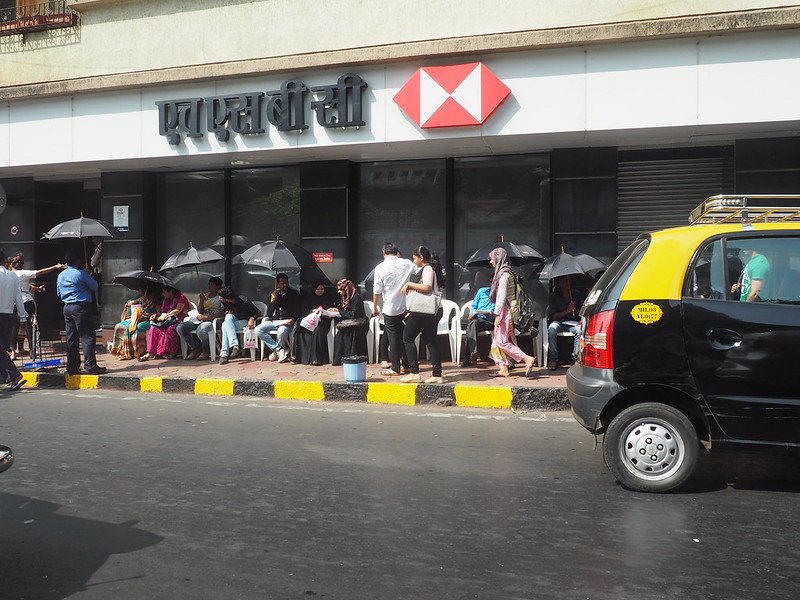
The act (of demonetisation) was an act of collective sacrifice. The people in long queues were reminded of the sacrifices of the soldiers guarding the nation’s borders and not to think of their own suffering. Indeed, it also helped to be told that the rich got it worse. Schadenfreude can be spiritually uplifting.
While sacrifice was demanded and expected, there was also the effort to minimise its scale. The lower denomination notes would remain legal tender, implying that the poor would suffer less as only the rich were expected to hold higher value currency. And, in the media and in official pronouncements, it was consistently portrayed as an ‘inconvenience’ and ‘temporary hardship’, for which the honest citizenry, was ever willing to bear the cost.
(…) there may be temporary hardships to be faced by honest citizens. Experience tells us that ordinary citizens are always ready to make sacrifices. (…) every citizen will stand up and participate in this ‘mahayagna’ and join the nation in the movement for purifying the country. (Prime minister’s speech of 8 November 2016).
Framed in these terms, the nation has little choice but to follow the leader. Everyone, the honest and the corrupt alike, were participants in this collective endeavour. However, when it came to the question of who was corrupt, apart from the cinematic villains, it a was just an abstract entity, a figure of speech. No one, whether a politician, bureaucrat or a businessman would admit to being corrupt and therefore were very much a part of this national festival of honesty (Burman 2016).
The real irony, and paradox, lies in the fact that the moral high ground claimed by the demonetisation narrative worked better than contesting narratives of observed reality.
In reality, the sacrifice called for was somewhat skewed in its impact. The suffering of the poor was disproportionately greater. A number of assertions made in the wake of demonetisation do not stand up to economic scrutiny. Claims such as “excessive cash fuelled inflation”, or “high value notes were mostly used for illegitimate transactions” were not substantiated though they served to reinforce the main narrative. That a large volume of cash returned to the banks was itself claimed as evidence of success, despite the earlier claims that it would not return. In the face of this onslaught of conflicting and contradictory information, a reasoned critique of the policy had very little chance of being heard.
The real irony, and paradox, lies in the fact that the moral high ground claimed by the demonetisation narrative worked better than contesting narratives of observed reality. It worked because it understood the nature of the moral economy of the poor 6 A moral economy is an economy that is based on goodness, fairness, and justice, as opposed to one where the market is assumed to be independent of such concerns (Thompson 1971). . Used to being at the receiving end of the state and its representatives, for the poor the impact of demonetisation would be one more blow in a series of blows they had to perforce deal with. At least in this instance, there would be a measure of justice if the rich were indeed to suffer more.
Public perceptions of the narrative
Most of the studies and media reports from the field referenced here were conducted in the immediate aftermath and in the year following the demonetisation. Opinion polls, media reports, impromptu surveys as well as anecdotal evidence showed that the policy had overwhelming public support (Dharia and Trisal 2017). Even when the real scale of hardship hit home; in terms of long queues, difficulties in exchanging the cancelled currency, and the very real prospect of loss of income and savings, there was a degree of ambiguity in criticising the decision. Most tended to distinguish the intention from the reality. That the policy was good but perhaps not implemented well seemed to be the main theme. Even political opponents were loath to criticise the intent and tended to concentrate on the faulty implementation. This effectively insulated the original sin – that the very design of the policy ensured its outcome.
A survey by researchers at IIT Delhi in the wake of demonetisation found a range of views, from strong support to cautious critique. However, what came through from the survey was the fact that the dominant narrative or at least its media version mattered more than the personal experience in shaping the popular understanding of the policy. The great deal of misinformation about the nature of black money, or the idea that opposing the move is viewed as endorsing corruption is a key factor in shaping public opinion (Khera 2017).
For the poor, demonetisation was not an isolated struggle. Indeed, in their perception, it was not even directed towards them. The real target, for once, was elsewhere.
A survey conducted in 28 slum neighbourhoods of Mumbai, recorded the loss of income, consumption and savings during the months of November and December 2016 following demonetisation. Among the various socio-economic and occupational groups included in the survey, income loss ranged from 14 to 44%with the self-employed suffering the most, their loss of savings was also higher compared to those with service jobs. However, a majority of the respondents, 56% of the sample, comprising both the categories, viewed the policy positively. Interestingly, the group with relatively higher education had a much higher positive view of the policy, compared to those with lower level of education. (Krishnan and Seigel, 2017).
A study of the very lowest segment of the urban economy, the waste-pickers of Pune, found interesting nuances in their perception and experience. The labouring poor, who were among the worst hit, did not perceive this as being directed against them. Their experience of the state, through forced evictions, abuse from the municipality, or the police, and other ‘interventions’, were much worse. For the poor, demonetisation was not an isolated struggle. Indeed, in their perception, it was not even directed towards them. The real target, for once, was elsewhere. Moreover,
The government has been shifting the goalposts of the exercise, making it difficult to align the spoken word with the underlying intent or purpose. However, in linking demonetisation with “black money,” it invoked a powerful construct that registered with the labouring poor (…).. For the poor (…) black money was something earned by unfair means. As an extension, it was money accumulated “at their expense” by informal/formal capital. ( Kalyan Shankar and Sahni, 2018)
Combining primary survey data with wholesale data, a study found that the retail traders in Bengaluru experienced an average of 20% decline in sales during November- December 2016. Despite the reported loss, 73% of the participants felt that ”it was good for the country”. A similar exercise in rural Odisha found an overwhelming 80% of the respondents thought that it was good for them although they were significantly hurt economically. (Banerjee and Kalra, 2019)
The possibility that the narrative succeeded beyond expectations lies in the fact that, despite the adverse consequences of demonetisation, the BJP was able to win a huge victory in the state of Uttar Pradesh followed by an even more emphatic win in the general election of 2019, to say nothing of the undiminished popularity of the Prime Minster. On the other hand, this could also be another narrative in the making.
Conclusions
The case of demonetisation demonstrates that popular narratives can trump economic facts. It is clear that where narratives succeed there is very little political cost. A failed policy that carries no cost is likely to generate more such policies. Unlike most economic shocks, which could be traced to endogenous or exogenous causes, demonetisation was an entirely self-inflicted shock, which was very likely carried out as much in a sincere belief in the narrative as in political calculation.
Demonetisation was a visible failure in terms of its stated objectives, and in spite of the pain inflicted on the vast majority of the population, there was little or no acknowledgement of this failure. Indeed, there was widespread appreciation of the action among the people. Essentially, the success of the demonetisation narrative lay in aligning it with the dominant cultural ethos: create a myth of a battle between good and evil, and the pervasive influence of the epics would do the rest. The mundane details did not matter.
The power of the narrative was such that, contrary to the accepted canon, there was very little loss of public confidence in the currency. The rapid remonetisation and the quantum of currency in circulation testifies to this fact. Recent evidence suggests that preference for cash has increased significantly in the wake of the heightened uncertainty from the COVID-19 pandemic. Paradoxically, public preference has been markedly in favour of higher denomination notes of Rs. 500 and Rs. 2000, whose share of the total currency in circulation in value terms is now around 83% (RBI 2019-20, p 179), very nearly the same as before demonetisation. Apparently the preference for cash, especially in times of stress, is stronger than faith in banks or digital transactions.
[T]he success of the demonetisation narrative lay in aligning it with the dominant cultural ethos: create a myth of a battle between good and evil, and the pervasive influence of the epics would do the rest.
The memory of demonetisation has faded or at least is no longer an active part of the discourse. One reason could be that while the economic effects of the policy may not have entirely dissipated, there is a perception that the effects were not lasting. The “perceptions” of the transient nature of the impact of demonetisation may itself be a part of another narrative. Moreover, it has been overtaken by many other events, currently the global pandemic. Undoubtedly, this will generate its own myths. But that is another story.
Notes:
Economic Survey (2016-17), Government of India
RBI Annual Reports (2016-17, 2017-18, 2018-19,2019-20)


